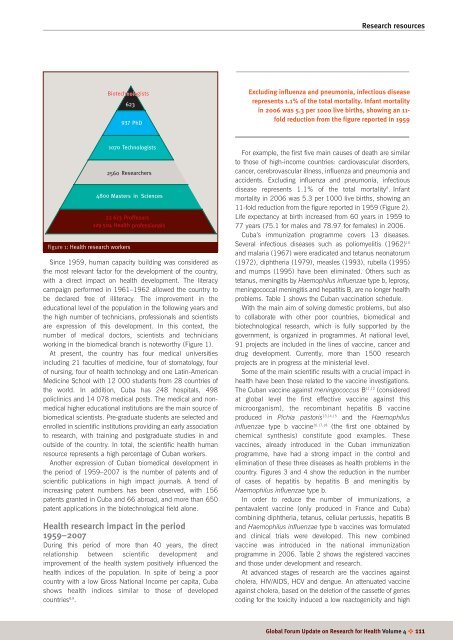Combining health and social protection measures to reach the ultra ...
Combining health and social protection measures to reach the ultra ...
Combining health and social protection measures to reach the ultra ...
- No tags were found...
Create successful ePaper yourself
Turn your PDF publications into a flip-book with our unique Google optimized e-Paper software.
Research resourcesBiotechnologists623 623937 PhD 937 PhDExcluding influenza <strong>and</strong> pneumonia, infectious diseaserepresents 1.1% of <strong>the</strong> <strong>to</strong>tal mortality. Infant mortalityin 2006 was 5.3 per 1000 live births, showing an 11-fold reduction from <strong>the</strong> figure reported in 19591070 Technologists1070 Technologists2560 2560 Researchers4800 Masters in Sciences4800 Masters in Sciences22 22613 Proffesors129 504 Health129 504 Health professionalsproffesionalsFigure 1: Health research workersSince 1959, human capacity building was considered as<strong>the</strong> most relevant fac<strong>to</strong>r for <strong>the</strong> development of <strong>the</strong> country,with a direct impact on <strong>health</strong> development. The literacycampaign performed in 1961–1962 allowed <strong>the</strong> country <strong>to</strong>be declared free of illiteracy. The improvement in <strong>the</strong>educational level of <strong>the</strong> population in <strong>the</strong> following years <strong>and</strong><strong>the</strong> high number of technicians, professionals <strong>and</strong> scientistsare expression of this development. In this context, <strong>the</strong>number of medical doc<strong>to</strong>rs, scientists <strong>and</strong> techniciansworking in <strong>the</strong> biomedical branch is noteworthy (Figure 1).At present, <strong>the</strong> country has four medical universitiesincluding 21 faculties of medicine, four of s<strong>to</strong>ma<strong>to</strong>logy, fourof nursing, four of <strong>health</strong> technology <strong>and</strong> one Latin-AmericanMedicine School with 12 000 students from 28 countries of<strong>the</strong> world. In addition, Cuba has 248 hospitals, 498policlinics <strong>and</strong> 14 078 medical posts. The medical <strong>and</strong> nonmedicalhigher educational institutions are <strong>the</strong> main source ofbiomedical scientists. Pre-graduate students are selected <strong>and</strong>enrolled in scientific institutions providing an early association<strong>to</strong> research, with training <strong>and</strong> postgraduate studies in <strong>and</strong>outside of <strong>the</strong> country. In <strong>to</strong>tal, <strong>the</strong> scientific <strong>health</strong> humanresource represents a high percentage of Cuban workers.Ano<strong>the</strong>r expression of Cuban biomedical development in<strong>the</strong> period of 1959–2007 is <strong>the</strong> number of patents <strong>and</strong> ofscientific publications in high impact journals. A trend ofincreasing patent numbers has been observed, with 156patents granted in Cuba <strong>and</strong> 66 abroad, <strong>and</strong> more than 650patent applications in <strong>the</strong> biotechnological field alone.Health research impact in <strong>the</strong> period1959–2007During this period of more than 40 years, <strong>the</strong> directrelationship between scientific development <strong>and</strong>improvement of <strong>the</strong> <strong>health</strong> system positively influenced <strong>the</strong><strong>health</strong> indices of <strong>the</strong> population. In spite of being a poorcountry with a low Gross National Income per capita, Cubashows <strong>health</strong> indices similar <strong>to</strong> those of developedcountries 8,9 .For example, <strong>the</strong> first five main causes of death are similar<strong>to</strong> those of high-income countries: cardiovascular disorders,cancer, cerebrovascular illness, influenza <strong>and</strong> pneumonia <strong>and</strong>accidents. Excluding influenza <strong>and</strong> pneumonia, infectiousdisease represents 1.1% of <strong>the</strong> <strong>to</strong>tal mortality 8 . Infantmortality in 2006 was 5.3 per 1000 live births, showing an11-fold reduction from <strong>the</strong> figure reported in 1959 (Figure 2).Life expectancy at birth increased from 60 years in 1959 <strong>to</strong>77 years (75.1 for males <strong>and</strong> 78.97 for females) in 2006.Cuba’s immunization programme covers 13 diseases.Several infectious diseases such as poliomyelitis (1962) 10<strong>and</strong> malaria (1967) were eradicated <strong>and</strong> tetanus neona<strong>to</strong>rum(1972), diph<strong>the</strong>ria (1979), measles (1993), rubella (1995)<strong>and</strong> mumps (1995) have been eliminated. O<strong>the</strong>rs such astetanus, meningitis by Haemophilus influenzae type b, leprosy,meningococcal meningitis <strong>and</strong> hepatitis B, are no longer <strong>health</strong>problems. Table 1 shows <strong>the</strong> Cuban vaccination schedule.With <strong>the</strong> main aim of solving domestic problems, but also<strong>to</strong> collaborate with o<strong>the</strong>r poor countries, biomedical <strong>and</strong>biotechnological research, which is fully supported by <strong>the</strong>government, is organized in programmes. At national level,91 projects are included in <strong>the</strong> lines of vaccine, cancer <strong>and</strong>drug development. Currently, more than 1500 researchprojects are in progress at <strong>the</strong> ministerial level.Some of <strong>the</strong> main scientific results with a crucial impact in<strong>health</strong> have been those related <strong>to</strong> <strong>the</strong> vaccine investigations.The Cuban vaccine against meningococcus B 11,12 (consideredat global level <strong>the</strong> first effective vaccine against thismicroorganism), <strong>the</strong> recombinant hepatitis B vaccineproduced in Pichia pas<strong>to</strong>ris 13,14,15 <strong>and</strong> <strong>the</strong> Haemophilusinfluenzae type b vaccine 16,17,18 (<strong>the</strong> first one obtained bychemical syn<strong>the</strong>sis) constitute good examples. Thesevaccines, already introduced in <strong>the</strong> Cuban immunizationprogramme, have had a strong impact in <strong>the</strong> control <strong>and</strong>elimination of <strong>the</strong>se three diseases as <strong>health</strong> problems in <strong>the</strong>country. Figures 3 <strong>and</strong> 4 show <strong>the</strong> reduction in <strong>the</strong> numberof cases of hepatitis by hepatitis B <strong>and</strong> meningitis byHaemophilus influenzae type b.In order <strong>to</strong> reduce <strong>the</strong> number of immunizations, apentavalent vaccine (only produced in France <strong>and</strong> Cuba)combining diph<strong>the</strong>ria, tetanus, cellular pertussis, hepatitis B<strong>and</strong> Haemophilus influenzae type b vaccines was formulated<strong>and</strong> clinical trials were developed. This new combinedvaccine was introduced in <strong>the</strong> national immunizationprogramme in 2006. Table 2 shows <strong>the</strong> registered vaccines<strong>and</strong> those under development <strong>and</strong> research.At advanced stages of research are <strong>the</strong> vaccines againstcholera, HIV/AIDS, HCV <strong>and</strong> dengue. An attenuated vaccineagainst cholera, based on <strong>the</strong> deletion of <strong>the</strong> cassette of genescoding for <strong>the</strong> <strong>to</strong>xicity induced a low reac<strong>to</strong>genicity <strong>and</strong> highGlobal Forum Update on Research for Health Volume 4 ✜ 111















![[re-tender] RFQ for supply of Diesel Generator - Brac](https://img.yumpu.com/44421374/1/186x260/re-tender-rfq-for-supply-of-diesel-generator-brac.jpg?quality=85)
